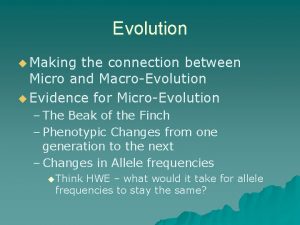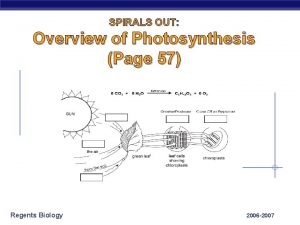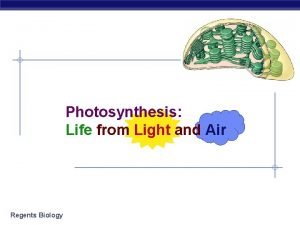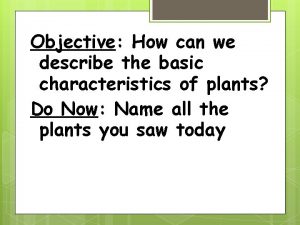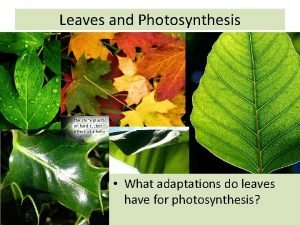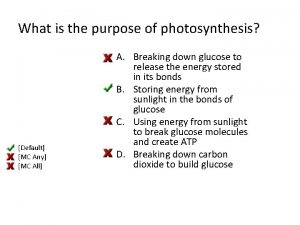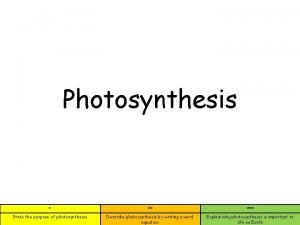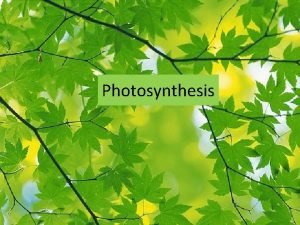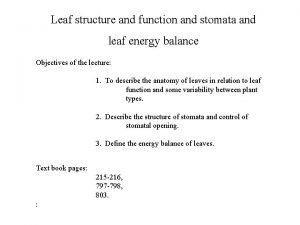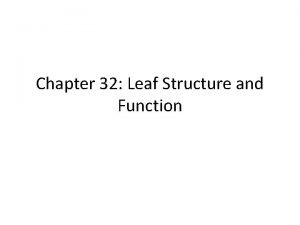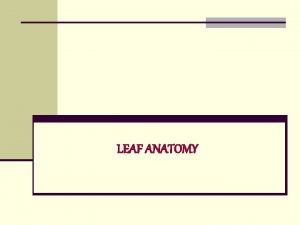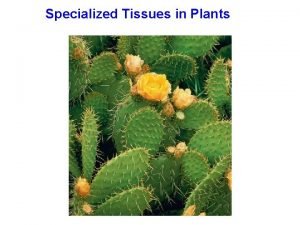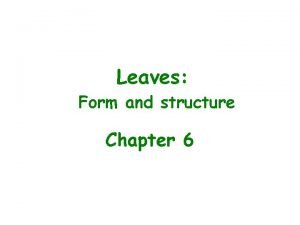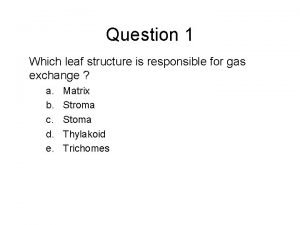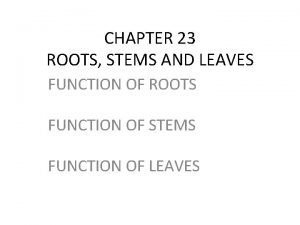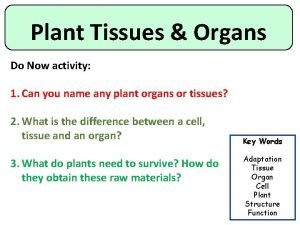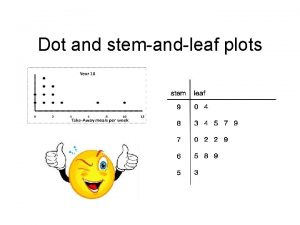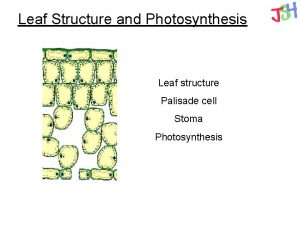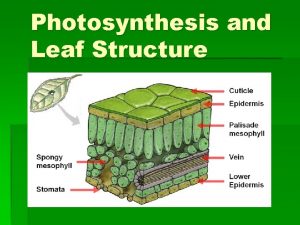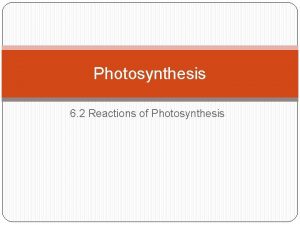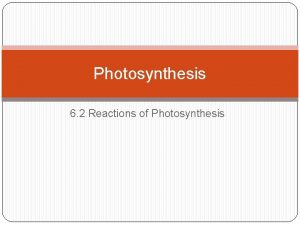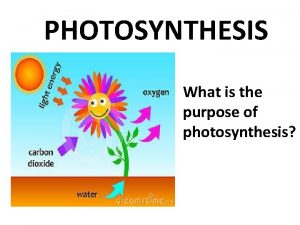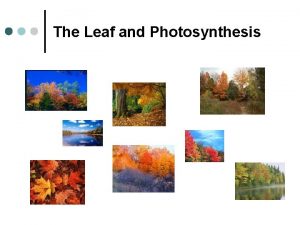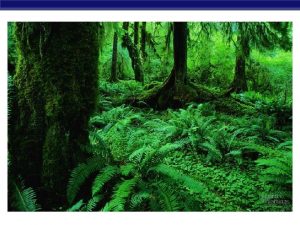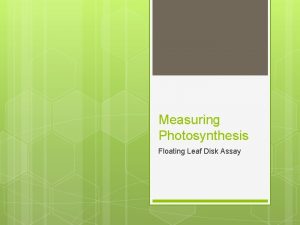Leaf Structure and Photosynthesis Purpose of a Leaf





















- Slides: 21

Leaf Structure and Photosynthesis

Purpose of a Leaf • Gas exchange- CO 2 and O 2 • Plants need CO 2 to carry out photosynthesis • Must release O 2 as a byproduct of photosynthesis • Capturing light that leads to Photosynthesis • Plants turn light energy into food

Leaf Structure • Cuticle • The waxy covering of the leaf used for protection and to prevent water loss • Epidermis • • Used for protection Includes the stoma and guard cells • Stoma • • • Opening where water vapor and gases leave and enter the plant Consist of two guard cells that open and close Usually located on the bottom of the leaf


Leaf Structure • Veins • Provide support • Transport water (through the xylem) and food (through the phloem) • Mesophyll • The middle layer of the cell where photosynthesis occurs • Spongy Mesophyll: loosely packed for gas exchange • Palisade Mesophyll: column-like and the area of the most • photosynthesis Contains the chloroplast

Chloroplast • Organelle that is the site of photosynthesis • Thylakoids • Disc-like sacs that are arranged in stacks called grana • Stroma • Fluid part of the chloroplast that surrounds the thylakoids

Chlorophyll • 2 Types of chlorophyll • Chlorophyll a • Chlorophyll b • A pigment used to absorb sunlight • Located in the thylakoids

Absorption of Chlorophyll Absorption Wavelength

Photosynthesis • Used by plants to turn sunlight into “food” in the form of glucose • 6 CO 2 + 6 H 2 O → C 6 H 12 O 6 + 6 O 2 • Consists of Light-Dependent and Light-Independent Reactions

Light-Dependent Reactions • Directly involved with sunlight • Reactions occur in the thylakoids • Use the sunlight to: • produce O 2 • Convert ADP and NADP+ into ATP and NADPH

Photosystems • Made up of chlorophyll and proteins • Absorb light to begin the process of photosynthesis • 2 types • Photosystem II • Photosystem I

Light Reactions • Water molecules (H 2 O) are split into O 2, H+ ions, and electrons • Oxygen released into the atmosphere • Electrons and H+ ions are used to form ATP and NADPH


Light-Independent Reactions • Also known as the Calvin Cycle • No light necessary • Uses the ATP and NADPH from the light-dependent reactions along with CO 2 to make sugars

Calvin Cycle • CO 2 molecules taken in from the atmosphere are combined to form 3 -carbon compounds • 3 -carbon compounds are used to form sugar • ATP and NADPH from the light-dependent reactions provide the energy to make the cycle “turn” • Takes 6 turns of the cycle to produce 1 molecule of glucose



Importance of Photosynthesis • Plants use the sugars for energy and for growth and development • Ex. Cellulose • Animals that consume plants can use this stored energy

Factors Affecting Photosynthesis • Temperature • Extreme temps can affect the enzymes that increase the rate of photosynthesis • Light • Increased amounts of light can increase the rate of photosynthesis • Water • A shortage of water can slow down or stop photosynthesis

C 4 Plants • Specialized chemical pathways that helps capture CO 2 at low levels • Can keep photosynthesis working at extreme temperatures • Ex. Corn, sugar cane

CAM Plants • Seen in very dry environments • Air is only let into the leaves at night to help prevent water loss during the day • Ex. Cacti, pineapple trees
 Maple leaf and oak leaf homologous
Maple leaf and oak leaf homologous Leaf and non leaf procedure
Leaf and non leaf procedure Leaf diagram photosynthesis
Leaf diagram photosynthesis Leaf diagram photosynthesis
Leaf diagram photosynthesis Leaf diagram photosynthesis
Leaf diagram photosynthesis What are the adaptations of leaf for photosynthesis?
What are the adaptations of leaf for photosynthesis? The purpose of photosynthesis
The purpose of photosynthesis Purpose of photosynthesis
Purpose of photosynthesis Purpose of photosynthesis
Purpose of photosynthesis Dictyledon
Dictyledon Cuticle leaves
Cuticle leaves Mesophyll function
Mesophyll function Two parts of leaf
Two parts of leaf Leaf structure
Leaf structure Internal structure of leaf
Internal structure of leaf Leaf structure questions
Leaf structure questions What are the functions of roots stems and leaves
What are the functions of roots stems and leaves Leaf structure diagram
Leaf structure diagram Give me a sentence
Give me a sentence Specific purpose statement
Specific purpose statement What is known as mother croon of bird
What is known as mother croon of bird Dot plot stem and leaf
Dot plot stem and leaf
